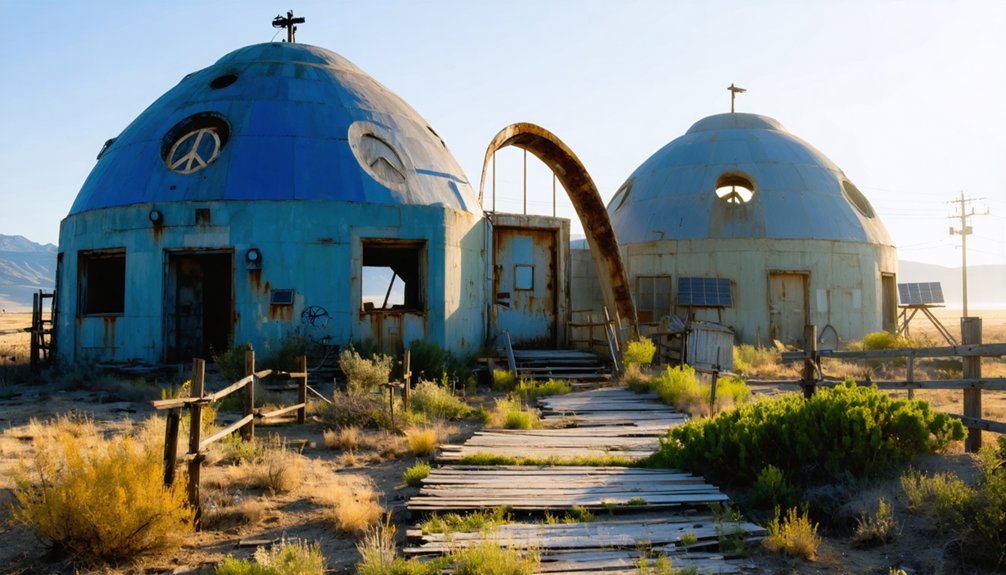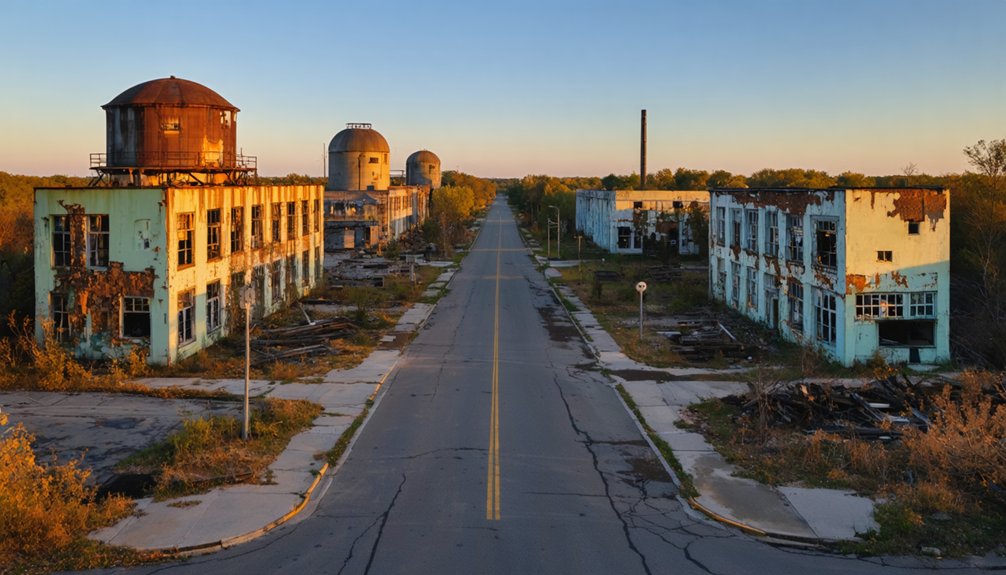America’s abandoned utopian communities offer fascinating glimpses into 19th-century social experiments. You’ll find New Harmony’s Protestant commune along Indiana’s Wabash River, Brook Farm’s Transcendentalist settlement in Massachusetts, Oneida’s controversial “complex marriage” community in New York, the Harmony Society’s Economy in Pennsylvania, and various Shaker villages scattered from Maine to Kentucky. These ghost towns, with their distinctive architecture and communal structures, preserve remarkable stories of idealistic visions that thrived before ultimately dissolving into history.
Key Takeaways
- New Harmony transformed from a thriving religious commune into a historical site after the Rappites dissolved their utopian experiment.
- Brook Farm’s transcendentalist community collapsed after just six years, leaving behind intellectual influence but abandoned physical structures.
- Economy (Harmony Society) gradually declined due to celibacy practices, finally dissolving in 1905 after 81 years of communal living.
- The Oneida Community’s radical social experiment ended in 1880, transitioning from utopian commune to silverware company while abandoning its original structures.
- Shaker Villages represent America’s longest-lasting utopian experiment, with abandoned settlements preserving their distinctive architecture and minimalist aesthetic.
New Harmony: From Religious Commune to Secular Experiment
While many Americans today know little about communal experiments of the early 19th century, New Harmony stands as one of the most significant utopian settlements in the nation’s history.
In 1814, German Pietists led by George Rapp established Harmonie along Indiana’s Wabash River, creating a self-sufficient community guided by Harmonist principles of celibacy, communal ownership, and preparation for Christ’s return. By 1820, Harmonie had become the most prosperous settlement in Indiana, producing and selling goods to markets across 22 states and 10 foreign countries. The Harmony Society emphasized hard work and communal living as essential components of their successful utopian vision.
The Rise and Fall of Brook Farm’s Transcendentalist Vision
Nestled in the pastoral landscape of West Roxbury, Massachusetts, Brook Farm emerged in 1841 as one of America’s most intellectually ambitious utopian experiments. Founded by former Unitarian minister George Ripley, this community embodied Transcendentalist ideals of mental freedom and social equality, uniting intellectual and manual laborers under one vision.
You’d find members earning equal wages regardless of their work, sharing housing and resources in a true communal living arrangement. The farm attracted luminaries like Nathaniel Hawthorne while publishing influential works through its magazine, *The Harbinger*. The community’s objective was to prepare a society of liberal, intelligent individuals who could lead wholesome lives away from competitive institutions. Starting with just 20 members, the community eventually grew to approximately 120 participants at its peak.
Brook Farm’s shift to Fourierism in 1844 marked the beginning of its downfall. The devastating fire that destroyed their uninsured Phalanstery in 1846, combined with financial struggles, forced the community to disband by 1847—leaving behind an enduring legacy despite its practical failure.
Oneida Community: Complex Marriage and Industrial Innovation
The Oneida Community of central New York stood in stark contrast to Brook Farm’s Transcendentalist experiment, showcasing a more radical approach to communal living from 1848 to 1880. Founded on Perfectionist theology, the community instituted “complex marriage,” allowing all adult members to engage romantically with any consenting adult, eliminating traditional family structures.
You’d have found their economic model equally revolutionary. After agricultural struggles, they pivoted to industrial production, achieving remarkable success manufacturing steel traps and silverware. Their communal labor system created nationally renowned products that funded their utopian experiment for decades. The Oneida Mansion House, constructed in 1862, served as the central living quarters for over 200 members. The practice of mutual criticism helped maintain social order by addressing undesirable character traits through group feedback sessions.
Though external criticism of their sexual practices ultimately contributed to their dissolution in 1880, their industrial legacy persisted through Oneida Limited. The community’s innovative social structure and business model challenged conventional American values while demonstrating how collective enterprise could flourish in a capitalist economy.
The Harmony Society’s Three Settlements: Economy’s Empty Streets
Founded in 1824 along the Ohio River, Economy represented the third and final chapter in the Harmony Society‘s pursuit of utopian idealism.
Located just 18 miles from Pittsburgh, this 3,000-acre settlement became a thriving hub of communal living, featuring homes, mills, orchards, and manufacturing facilities.
Economy’s history reflects both the strengths and inherent contradictions of utopian experiments. While the Society created remarkable industrial prosperity, their practice of celibacy guaranteed their eventual extinction. The group’s commitment to communal ownership was formalized in their 1805 Articles of Association, which established their unique economic structure.
After George Rapp’s death in 1847, membership steadily declined until the community’s dissolution in 1905.
Today, you’ll find Economy’s empty streets lined with preserved buildings—silent reminders to a once-thriving experiment in collective prosperity.
These architectural remnants, now part of Ambridge’s historic district, invite you to contemplate the delicate balance between idealism and sustainability. The Society’s significant oil discoveries in Warren County resulted in six million dollars in profits that funded their communal endeavors.
Remnants of Shaker Villages: Craftsmanship Among the Ruins
Scattered across the American landscape from Maine to Kentucky, abandoned Shaker villages stand as evidence to one of the most distinctive utopian experiments in American history.
You’ll find these architectural treasures at sites like Watervliet near Albany—America’s first Shaker settlement—and the expansive Pleasant Hill in Kentucky with its 30 original structures.
Shaker architecture embodies their core values through minimalist design, functionality, and unadorned aesthetics.
The 1826 Round Stone Barn at Hancock and Mount Lebanon’s Great Stone Barn showcase their engineering brilliance.
While many villages faced decline in the late 19th century, their legacy persists in preserved spaces like Hancock Shaker Village’s 20 original buildings.
The craftsmanship that defined these communities—evident in furniture, textiles, and tools—continues to influence modern design with its elegant simplicity.
Many Shaker villages were renowned for their self-sustaining communities that combined agricultural expertise with innovative manufacturing techniques.
During the Era of Manifestations, Shakers produced remarkable gift drawings that are now recognized as significant contributions to American folk art.
Frequently Asked Questions
How Did Utopian Communities Handle Punishment for Breaking Community Rules?
Like a delicate balancing act, utopian communities employed punishment methods ranging from rehabilitation to slavery, while maintaining community enforcement through collective responsibility, councils, social pressure, and restorative labor—all aimed at preserving social cohesion.
Did Any Utopian Communities Successfully Transition to Sustainable Modern Towns?
Yes, you’ll find places like Amana Colonies and Oneida successfully evolved through sustainable practices and reformed community governance, maintaining their distinct identities while integrating into modern economic and social frameworks.
What Clothing and Fashion Norms Existed in These Communities?
Like threads in a social tapestry, you’d find communal attire emphasized simplicity and equality. Your clothing would reflect utilitarian values, with fashion evolution occurring only as communities integrated with mainstream society or disbanded.
How Were Children Educated Within These Isolated Utopian Settlements?
You’d find children immersed in alternative education systems that integrated manual labor with intellectual pursuits. Community curriculum emphasized self-reliance, critical thinking, and egalitarian values—regardless of gender or social background.
Did Members Retain Their Personal Wealth After Joining These Communes?
Penny for your thoughts? You’d typically surrender personal assets upon joining, converting them into communal resources through shareholding arrangements. Some communities allowed withdrawal of contributions if you departed before dissolution occurred.
References
- https://open.baypath.edu/his114/chapter/utopian-communities/
- https://en.wikipedia.org/wiki/Wikipedia:WikiProject_Ghost_towns
- https://www.nps.gov/articles/000/secular-utopias-in-america.htm
- https://figshare.le.ac.uk/articles/thesis/The_Archaeology_of_Abandonment_Ghost_Towns_of_the_American_West/10120007
- https://fee.org/articles/the-dark-side-of-paradise-a-brief-history-of-americas-utopian-experiments-in-communal-living/
- https://vitabrevis.americanancestors.org/2020/12/ghost-towns
- https://en.wikipedia.org/wiki/List_of_American_utopian_communities
- https://en.wikipedia.org/wiki/Ghost_town
- https://guides.loc.gov/chronicling-america-early-utopian-communities
- https://www.geotab.com/ghost-towns/



